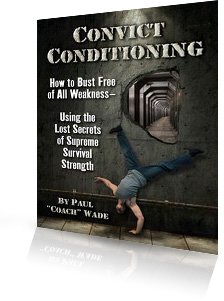Paul Wade went into the California prison system in 1979 to serve a long sentence among the nation's most hardened criminals. He emerged more than two decades later with a sentence for the rest of us, in the form of his acclaimed 2009 book Convict Conditioning: How to Bust Free of All Weakness Using the Lost Secrets of Supreme Survival. His decree: Do six moves: Push-ups, pull-ups, squats, handstands, a forward abdominal bend, and a backward spinal bridge. That's it. And if you do them with "the right knowledge and a big bucketful of determination," that's enough.
Scrolling through the strength programs outlined on fitness websites—including this one—and you'll probably wonder exactly how that could be enough. Push-ups and pull-ups in the modern gym are usually either appetizers or dessert—a pre-exhaust warm-up, or in immense quantities to "rep out" after a hard workout. Wade's system made them the main course by focusing on steps rather than reps.
In Convict Conditioning, each of the "big six" is broken down into 10 progressive stages, each culminating in a benchmark rep goal. If knocking out 40 push-ups is a breeze, good for you; you're still only at step five. You've earned the right to do arrowhead push-ups instead. The ultimate goals in this model are "master steps" like the pistol squat and one-armed pull-ups, each one earned by long periods of regular practice. In the 2011 follow-up Convict Conditioning 2, Wade integrated more complicated goal moves like the clutch flag, the neck bridge, and fingertip push-ups.
In and around the intensive technique explanation of these manuals, he crafts an intricate narrative of bodyweight training through history, weaving in the ancient Greeks, monks, prisoners, and legendary strongmen like Charles Atlas. "They might have demonstrated their power by unleashing it on external objects like nails and barrels," he writes of these men, "but in many cases they actually built that basic strength through control of the body."
Last year, the reigning purist of bodyweight training released the Convict Conditioning DVD Series, filmed at none other than Alcatraz. Only five of the "Big Six" have been covered in this series thus far (no handstand push-ups yet), and the 10 steps are accompanied by 10 "commandments" for each movement, detailing technique onscreen and in illustrated manuals.
Wade isn't known for giving out many interviews. However, he recently took a break from working on the forthcoming Convict Conditioning 3 to have an email chat with Bodybuilding.com about "the ultimate barbell you can take with you everywhere," as well as the Progressive Calisthenics Certification, a series of workshops he recently launched with Bodybuilding.com contributor Al Kavadlo.
To me, calisthenics is mastery of body movement. Nothing else. In calisthenics, you move your body—not a barbell, a dumbbell, machine, infomercial gadget, or anything else. As such, calisthenics is not a side discipline of fitness. It must be the center, the core of all training. All of it.
Yoga and flexibility training are just about moving the body in certain ways; that's calisthenics. Running, swimming, and all basic cardio are moving the body; that's calisthenics too. Balance training on the beam or upside-down in a handstand, that's calisthenics. Agility and explosive work, tumbling, jumps, flips and kicks—it's all calisthenics. The most primal form of strength training involves using the body's own weight to build strength through movement. That's calisthenics, also.
Using progressive techniques, an expert can take any bodyweight exercise from a ridiculously easy rehab level all the way up to the limit of human power and ability, a "holy shit" level. Pull-ups are a good example. Most coaches only know about regular two-arm pull-ups, but what about easier versions like jackknife pull-ups, or leg-assisted pull-ups? And what about harder pull-ups?
Just like barbell or dumbbell training, if you want to get stronger, you hit a target number of reps and then make things tougher. With barbell training this is easy; you just add more weight. With calisthenics it's more sophisticated, because you need to be taught the exercise progressions. I can teach you 30 or more distinct progressions leading you up to one-arm pull-ups. By the time you can pump out six one-arms, you will have the strength to snap the average bodybuilder's bones in an arm-wrestling match. You'll also have biceps like kegs of beer. This, to me, is true progressive calisthenics. But who teaches this kind of shit anymore? It's been mostly lost in the outside world.
The biggest mistake people make about bodyweight-only training is the idea that it is good for basic conditioning, but cannot build high levels of muscle and strength. To people who think this way, I say: Yes it can. You just need to know how to use the exercises progressively.
In reality, bodyweight training and serious muscle gain go hand-in-glove. You just have to take a look at an Olympic gymnast to see that. These guys only use bodyweight, but they often have physiques which would see them winning natural bodybuilding shows. And they don't even train to gain mass. Imagine what they would look like if they did!
The same is true for strength. If anyone tells me that bodyweight-only work can't make them strong, I challenge them to get to the stage where they can bust out:
- 5 one-arm push-ups (prison-style, with the feet close)
- 5 one-arm pull-ups (no kipping)
- 10 handstand push-ups
- 20 pistol squats
- 20 strict hanging leg raises
- 10 stand-to-stand bridges
Then come back and tell me that they aren't Spiderman-strong.
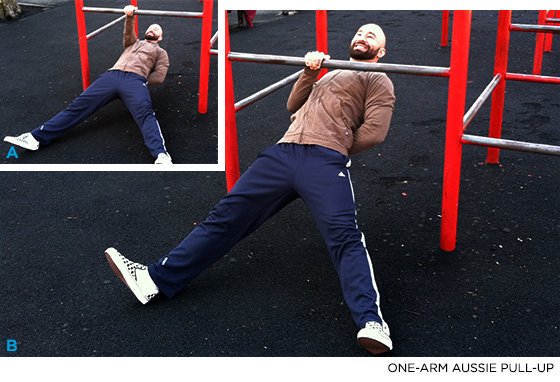
I think what surprises most athletes who try it is the effect bodyweight strength work has on the joints. There's no getting around this: Done right, bodyweight training strengthens your joints instead of wearing them down. Why? Because the body was meant to move itself. We literally evolved to push and pull ourselves around, and to squat and jump using bodyweight.
This is why all bodybuilders should include a bodyweight base to keep the joints strong. I'm a big believer that you should master bodyweight before using weights. If you can't do a bodyweight squat correctly, how in Christ's name are you going to squat heavy and get it right? You need to build the bodyweight neural patterns, the tendons, and the deep tissues before bulking up and hoisting up the big iron. All the legendary old school bodybuilders and lifters performed bodyweight work along with the weights. This was true right up to the '60s.
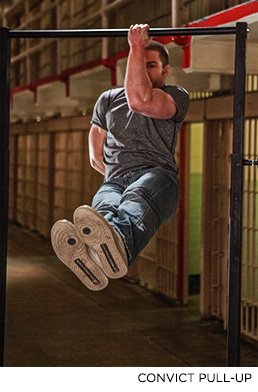
Today you have young guys piling mountains of iron on the leg press to perform teeny-tiny little reps, but they can't do a single full one-leg squat—and they wonder why their knees hurt all the time. Kids load up the bar for bench presses when they can't even do 20 deep push-ups. Bodybuilders blow out their backs all the time bending over to heave up weight on the barbell row, when they aren't even close to doing 10 strict pull-ups. It's no coincidence many bodybuilders are so racked with pain. It doesn't have to be this way.
I get emails and letters all the time from young and old athletes who write to say they thought they would never train again because their knees, backs, shoulders or wrists were busted up. Six months of progressive calisthenics and these "hopeless cases" are amazed to be as lithe as tigers. They have cured their joint pain and arthritis, and are stronger and bigger than ever—with less body fat as a bonus.
None of this is a dis to weight training, or any shit like that. Many of the [Progressive Calisthenics Certification] instructors either use weights themselves, or still train clients with weights at times. But progressive calisthenics is an incredibly valuable and totally underused tool, especially for bodybuilders. I even wrote a post for bodybuilders on the PCC blog inviting you guys and girls to join us.
That's a great point. Most folks forget that the adjustable barbell is only just over a century old. That's nothing! For the rest of human history—stretching right back to when we were swinging in trees—our species built its strength using bodyweight.
Like you say, progressive bodyweight techniques can be found in martial arts and yoga systems dating back thousands of years. Herodotus tells us that the Spartan warriors at the Battle of Thermopylae performed strength calisthenics—this was 25 centuries ago. Bodyweight progressions can also be found in prison systems, modern gymnastics styles, and military conditioning methods. To me, progressive calisthenics isn't in competition with any of these fine traditions; it's a distillation of the best techniques and tactics from all of them, systematized into logical order and field-stripped so all you need to find is a bar to hang from.
I'm way too old for any of the "mine is bigger than yours" bullshit when it comes to comparing bodyweight strength approaches. It's a waste of time. I respect all athletes and wannabe athletes, whatever their method or mindset. Many athletes from other systems—martial arts, yoga, gymnastics—have already signed up to be part of the PCC team. The skills and strategies athletes learn with us will be taken back to their own disciplines, and similarly our community will be richer from their input. It's an exciting time to get involved in bodyweight training. Maybe the best time ever.
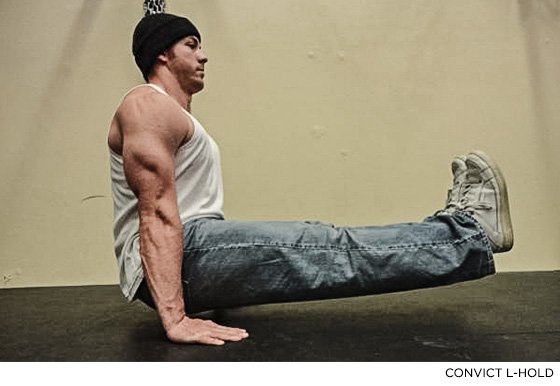
A certification for bodyweight strength is not necessary. You don't need to buy a damn thing to benefit from calisthenics. As far as I'm concerned, as long as your doc is OK with it, you can practice and master bodyweight techniques and progressions by yourself in your basement, in your bedroom, or in the park. Hell, the majority of the great bodyweight athletes I've met did most of their learning alone in cells.
Nobody is required to attend this cert. In fact, I hope folks reading this will want be part of the PCC community even if they never plan to attend. But if you want to get some focused expert coaching that can accelerate your personal learning curve dramatically, or maybe if you train others for a living and want the best "toolbox" at your disposal, then I'd rather athletes have the option of getting qualified with the super-trainers at Dragon Door [Publications]. If you spend three solid days of intensive training with Al Kavadlo, you are guaranteed a quantum leap in your knowledge and abilities. You will be revolutionized.
Oh Jesus. How do I answer that? Progressive calisthenics is for everyone. I've trained bodybuilders who were looking for a fresh burst of muscle growth and powerlifters interested in seeing what new strength tricks calisthenics could teach them. I get a mix of young and old. Most of the older athletes are using calisthenics to heal old dings and build strength without incurring new injuries. Many of the younger athletes who contact me now are interested in bodyweight because it's cool; the funky shit appeals to them.
Unless you are a weight trainer, a heavy bench press just looks kinda boring, but bodyweight moves like muscle-ups, flags, L-holds, handstand push-ups, and one-arm pull-ups? They impress people. They are fun and challenging to learn. Young athletes are leaving the gyms in a mass exodus. They are training outdoors, in parks, doing bodyweight arts like parkour.
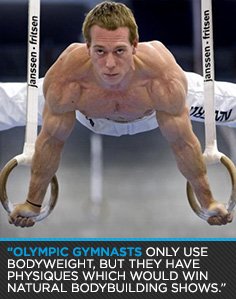
It doesn't matter what level you are currently at—Olympic athlete or couch potato—everyone can, and should, be doing bodyweight work. Age is not a factor, either. Children take to bodyweight exercises very easily. It's like play to them. Because there is no external load, young kids, even infants, can train with zero risk to their growth. Most bodybuilders think they are too old when they hit 40, but bodyweight athletes are still strong at 70, 80, and beyond. Unlike most other disciplines, bodyweight strength training becomes more important as you get older, not less.
Elderly men and women don't need a huge bench press or deadlift; they need to be able to squat in and out of chairs. If they fall, they need the strength to press themselves back up again. This is all bodyweight training!
The most important difference between Convict Conditioning and PCC is that Convict Conditioning is just about building raw muscle and strength using bodyweight only. This was the kind of goal inmates all had, and the workouts in the book were built around this goal. PCC is not tied to any specific objectives. It's more like a toolbox you can dip in and out of; once you learn how the progressions work, you can tailor them to any goal you have in mind. This can be muscle-building, strength, skill, and balance in static holds, functionality, mobility, joint health—whatever.
I liken PCC to a "bodyweight barbell." Once you know how to change the plates on a barbell, you can adjust it and use it for any training goal, from strength and power, to fitness, to building muscle, to endurance. You can do almost anything with a barbell. PCC teaches you how to make your own body a barbell—the ultimate barbell you take with you everywhere.

